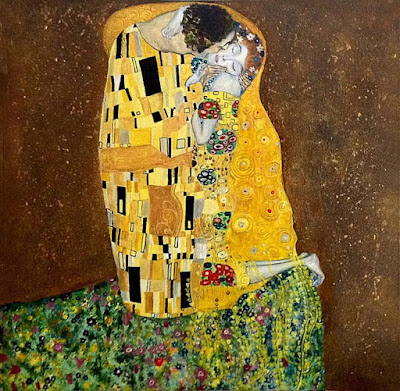We all love art, and we all love Europe, so I hope you'll enjoy the following list.
01. Austria - The Kiss, Gustav Klimt, 1908.
02. Belarus - The Fiddler, Marc Chagall, 1913.
01. Austria - The Kiss, Gustav Klimt, 1908.
02. Belarus - The Fiddler, Marc Chagall, 1913.
03. Belgium - The Son of Man, René Magritte, 1964.
04. Bosnia & Herzegovina - Mountain Landscape, Karlo Mijić, 1924.
05. Bulgaria - Rachenitsa Dance, Ivan Mrkvička, 1894.
06. Croatia - Roman Woman Playing A Lute, Vjekoslav Karas, 1845-47.
07. Cyprus - Cyclist in a Landscape, Stelios Votsis, 2005.
08. Czech Republic - The Absinthe Drinker, Viktor Oliva, 1901.
09. Denmark - The Little Mermaid, Edvard Eriksen, 1913.
10. Estonia - Half Nude in Striped Skirt, Adamson-Eric, Year Unknown.
11. France - Impression Sunrise, Claude Monet, 1872.
12. Germany - Wanderer above the Sea of Fog, Caspar David Friedrich, 1818.
13. Greece - Venus de Milo, Alexandros of Antioch, 130-100 BC.
14. Hungary - The Old Fisherman, Tivadar Csontváry Kosztka, 1902.
15. Iceland - Þingvellir, Þórarinn Benedikt Þorláksson, 1900.
16. Ireland - Three Studies of Lucian Freud, Francis Bacon, 1969.
17. Italy - Mona Lisa, Leonardo da Vinci, 1503-06.
18. Lithuania - Tale of the Kings, Mikalojus Konstantinas Čiurlionis, 1909.
19. Luxembourg - Stretch of the Moselle at Greiveldange with Stadtbredimus, Nico Klopp, 1930.
20. Moldova - The Girls From Ciadar-Lunga, Mihail Grecu, 1960.
21. Malta - The Beheading of Saint John the Baptist, Caravaggio, 1608.
22. The Netherlands - Girl with a Pearl Earring, Johannes Vermeer, 1665.
23. Norway - The Scream, Edvard Munch, 1893.
24. Poland - Rejtan, or the Fall of Poland, Jan Matejko, 1866.
25. Portugal - Le Fado, José Malhoa, 1910.
26. Romania - Car Cu Boi, Nicolae Grigorescu, 1899.
27. Russia - Golden Autumn, Isaac Levitan, 1895.
28. Serbia - The Wounded Montenegrin, Paja Jovanović, 1882.
29.Slovenia - Pomlad, Ivan Grohar, 1903.
30. Spain - Guernica, Pablo Picasso, 1937.
31. Sweden - Breakfast under the Big Birch Tree, Carl Larsson, 1895.
32. Switzerland - The Walking Man, Alberto Giacometti, 1960.
33. Turkey - The Tortoise Trainer, Osman Hamdi Bey, 1906.
34. Ukraine - Reply of the Zaporozhian Cossacks, Ilya Repin, 1880-91.
35. United Kingdom - The Fighting Temeraire - Joseph Mallord William Turner, 1838.
Do you agree with my list?
Please do not forget to Like, Share and Subscribe.



































Comments
Post a Comment